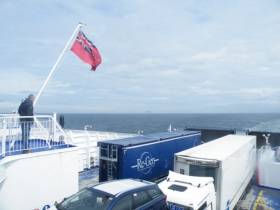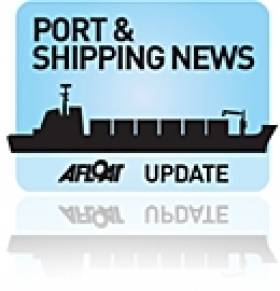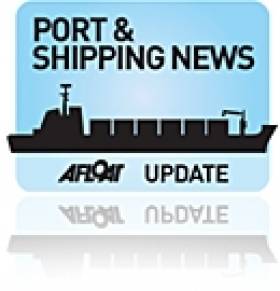Displaying items by tag: IMDO Weekly Market Review
IMDO Review: Brexit Raises Foyle Dispute, Shiprepairs Boosts Retrofits & Hapag-Lloyd Acquire UASC
#IMDOreview: The Irish Maritime Development Office (IMDO) Weekly Market Review which is produced in-house returns this week with coverage of domestic and global shipping news.
Irish Maritime News: Brexit has revived a dormant territorial dispute between Britain and the Republic of Ireland over the ownership of Lough Foyle as also reported on Afloat.ie. Lough Foyle in Derry and Carlingford Lough, between Counties Louth and Down, are both matters of dispute between Dublin and London.
Ship repair market could see huge boost on retrofits: A series of new regulations, most notably the Ballast Water Management Convention, as well as the recent cap on the use of sulphur fuels, is bound to lead to increased retrofits; since shipowners will gradually look to keep their vessels compliant.
EU Commission approves container liner shipping merger: The European Commission has cleared under the EU Merger Regulation the proposed acquisition of United Arab Shipping Company (“UASC”) by Hapag-Lloyd of Germany, subject to conditions. Both companies operate in the container liner shipping sector.
For more stories of this edition which is available here in addition to Afloat's dedicated Ports & Shipping news coverage.
IMDO Review: Fears of Marine Test Site, Operator Adds to Global Decline & Port Profits Rise
#IMDOreview: The Irish Maritime Development Office (IMDO) Weekly Market Review which is produced in-house returns this week with coverage of domestic and global shipping news.
test site off Spiddal could pave the way for a fish farm in Galway Bay ‘through the back door’.
Global Maritime News: Hanjin’s returning: Charters and Selling Ships, Depressing Global Shipping Assets Hanjin Shipping's asset sales have started with three ships under charter sold by their owners last week, setting off a potential decline in ship values worldwide as the beleaguered maritime industry comes under renewed pressure.
Abu Dabi Port Profit up 77% in the First Half of 2016 Abu Dhabi Ports on Tuesday reported a 77 per cent rise in net profit for the first half of the year on the back of growth across all segments. The ports operator, which said revenue grew 20 per cent during the period, did not provide a monetary value.
For more stories of this edition which is available here in addition to Afloat's dedicated Ports & Shipping news coverage.
IMDO Review: Stena On Brexit, UK Shipping Calls for Free Trade, Expanded Panama Canal & More
#IMDOreview - The latest Irish Maritime Development Office (IMDO) Weekly Market Review has among the following stories as outlined below.
Irish Maritime News: Brexit: Stena Line Discuss the Impact of Brexit - As reported also on Afloat.ie, Stena Line has said it will have to assess how Brexit could impact the UK.
The Swedish company, which sails from Holyhead to Dublin, employs hundreds of workers in North Wales. A Stena Line spokesman said: "As Brexit is a completely new situation Stena Line will have to evaluate its potential impacts from a number of different perspectives.”
Brexit: UK Chamber of Shipping Calls for Free Trade Commission Assistance - In response to last week's decision by the UK to leave the European Union (EU) in the so-called "Brexit" referendum, the UK Chamber of Shipping has issued a call for the government to establish a new Free Trade Commission for the country in order to support, among other things, the country's shipping industry.
Global Maritime News: Expanded Panama Canal - The newly expanded Panama Canal is expected to boost trade between China and Latin/South America as it makes the flow of goods between the two regions easier and more efficient, a Mexican expert on Asia said.
Jose Luis Leon-Manriquez of Mexico City’s Autonomous Metropolitan University, spoke with Xinhua following the opening of the expanded canal on Sunday, with the inauguration ceremony featuring a huge Chinese container ship (COSCO Shipping Panama, Afloat adds) passing through the waterway.
For more on the above stories and other news items, click the IMDO Market Review (Week 26) here.
In addition to further dedicated coverage visit Afloat.ie's Ports & Shipping news.
IMDO Review: New Port Safety Code, Shipping Indices Perform Badly & New Suez Canal Branch
#IMDOreview -The Irish Maritime Development Office (IMDO) latest Weekly Market Review has among the following stories as outlined below.
Irish Maritime News: HSA Publish New Code of Practice for Health and Safety in Dock Work. On Monday the 30th of November, the Health and Safety Authority published ‘Code of Practice for Health and Safety in Dock Work’. This new Code of Practice was written by the Health and Safety Authority in consultation with representatives from the Irish ports and docks sector.
The Code applies to commercial ports and dock premises, harbours and canals where goods and passengers are transported, handled or held for the purpose of loading or unloading ships.
Global Maritime News: Shipping Indices Perform Badly in 2015 as World Trade. Growth Underperforms Shipping Indices have performed badly this year as world trade has remained subdued. The Shanghai Containerized Freight Index (SCFI), which reflects spot rates for container transport from Shanghai to the rest of the world, has declined by as much as 47% so far this year.
New Canal Branch of Suez Canal: The new canal branch of the Suez Canal, inaugurated last August, has generated revenue of $1.4 billion during the last three months. During a press conference on Wednesday, Mahmoud Rizq, a member of the board of directors of the Suez Canal, noted that the canal has accomplished revenue of $4.3 billion during the past 10 months, which is equal to 32 billion Egyptian pounds.
For more on the above stories and other news items, click the IMDO Market Review (Week 49) here.
In addition to further dedicated coverage visit Afloat.ie's Ports & Shipping news.
#Ports&Shipping – The latest IMDO Weekly Market Review includes the following stories outlined below.
Irish Maritime News: National Ports Bill Enactment - Minister for Transport, Tourism & Sport, Paschal Donohoe will publish a new Bill as reported on Afloat.ie to provide for the transfer to local authority control of the five Ports of Regional Significance – Drogheda, Dún Laoghaire, Galway, New Ross and Wicklow.
The Bill will also make improvements to the board appointment process, such as introducing statutory skillsets and term limits which will improve the overall corporate governance of the sector.
Global Maritime News: Indian Cabinet clears Merchant Shipping Bill - The Indian Union Cabinet has given its approval for the introduction of the Merchant Shipping (Amendment) Bill, 2015, in line with a global convention, to protect environment and human health from ballast water and sediments used in ships, which can include harmful aquatic organisms and pathogens.
Container Market: US West Coast Containership Congestion - During February and March the containership capacity delayed outside the five largest US West Coast ports reached over 0.2m TEU, equivalent to 1.2% of the containership fleet. These delays led to a number of cargo diversions away from the West Coast, and a wider impact on the boxship sector. As a result of this congestion, throughput at the major West Coast ports contracted in early 2015, falling by 19% y-o-y in the first two months.
Emissions: Big data helps shipping lines cut fuel bills and emissions -By focusing on operational improvements, shipping companies are reducing fuel consumption, saving money and cutting greenhouse emissions, while continuing to increase the amount of freight transported.
Irish Business News: Exports by Irish Companies Hits All Time High - It has been reported by Government that exports by Irish companies increased by 10% during 2014 to hit an all-time high of €18.6bn. This growth was recorded in exports to all international markets and across all sectors, according to the official figures published by Enterprise Ireland.
For more of each of the above stories and much more click the IMDO Market Review (Week 18) here.
In addition to further dedicated coverage visit Afloat.ie's Ports & Shipping news.
IMDO Shipping Review: EU Co-Fund Dublin Port Studies, Vessel Spill Clean-Up, Maersk Rule the World, Bunker Energy System and More
#Ports&Shipping –The latest IMDO Weekly Shipping Market Review includes the following stories as detailed below.
Irish Ports: EU Programme Co-Funds - Capacity Studies on Port of Dublin. As previously reported on Afloat.ie, almost €2.5 million from the EU TEN-T Programme will fund studies into the capacity development of the Port of Dublin.
Environment: Clean-up under way after oil spill from ship in Warrenpoint Harbour. A clean-up operation is under way after a spill of 100 litres of heavy fuel oil from a vessel berthed at Warrenpoint Harbour spread to the shore.
Container Market: Maersk rules the world's commercial shipping lanes. Shipping containerisation has become dominant in every port in every country in the world and accounts for 90pc of global trade.
Innovation: First Installation for Bunker Saving Solar Energy System - Renewable energy systems company Eco Marine Power (EMP) has installed a fuel-saving system with a solar panel array on a Greek ferry.
For more on each of the above and other stories click PDF download: IMDO Weekly Markets Review (Week 44). In addition to coverage on Afloat.ie's dedicated Ports & Shipping News section.
IMDO Shipping Review: Cork Port Achieves Environment Certificate, 'Box' Rates Decrease,Tankers Target Threat, Scrubbers Most Economic and More
#Ports&Shipping –The latest IMDO Weekly Shipping Market Review includes the following stories as detailed below.
Irish Ports: Cork Port Receives Recognition for High Environmental Standards – (as previously reported on Afloat.ie), the European Sea Ports Organisation (ESPO) was delighted to congratulate the port of Cork, for achieving the Port Environmental Review System (PERS) certification. The port's fourth consecutive occasion to be awarded a PER certification since its inititial launch in 2006.
Container Market: Analysts predict rise in volume but decrease in rates for 2015, as operators look to GRI's for improvements. Drewery's expect growth across major trade lanes to hit a "relatively positive" year-on-year 5.5% in 2015 in its Outlook for Container Shipping Webinar presentation on Thursday. However Drewry's predicted that average rates will decline by 3-4% globally next year, highlighting the need for operators to cut costs.
Tanker Market: Al-Qaeda targets tankers - Security contractors believe tankers and other types of commercial tonnage could become increasingly attractive targets for Islamic terrorists in the months ahead. On Monday MAST joined the growing list of firms that are warning clients to be vigilant in the wake of reports that Al-Qaeda is urging followers to take aim at tankers bound for the West.
Environment: Scrubbers Are the Most Economic Option for Shipowners - Scrubbers are the most economic option for companies looking to become compliant with Emission Control Area (ECA) regulations. Scrubbers, which are outfitted on engines to remove sulphur from heavy marine fuel, are the least disruptive method to meet the regulations. Beginning 2015, sulphur content in marine fuel used in ECAs will not be allowed to exceed 0.10 per cent.
For more on each of the above and other stories click HERE for IMDO Weekly Markets Review (Week 43). In addition to coverage on Afloat.ie's dedicated Ports & Shipping News section.
IMDO Shipping Review: Shannon Seek Deepwater Facility Operators, US Approve 2M Alliance, Global Capacity Threat and More
#Ports&Shipping –The latest IMDO Weekly Shipping Market Review includes the following stories as previously reported on Afloat.ie, Dublin Port's Record Trade and Record Profits at Shannon Foynes Port Company plus stories below and more from the IMDO.
Shannon Estuary: Shannon Foynes Port Company- Seeking Deepwater Facility Operators – SFPC is beginning to recruit commercial operators for new deepwater facilities. It is planning to develop the facilities to handle the increase in the size of cargo vessels. Their maximum size is expected to go from 80,000 tonnes to 120,000 tonnes from next year as a result of the deepening of the Panama Canal, which will allow shipping companies to use much larger craft.
Container Market: Maersk secures 2M alliance approval in the US - The U.S. Federal Maritime Commission on Thursday approved an alliance that will carry about one-third of all cargo across the world's busiest ocean trade routes, made up of the world's two biggest container-shipping companies in terms of capacity. The so- called 2M alliance unites Maersk Line, a unit of Danish conglomerate A.P. Møller-Mærsk, and Switzerland-based Mediterranean Shipping Co.
Capacity: Capacity threat will cloud the next 12-18 months - Rates in global shipping could rise, but only moderately, in the next 12-18 months, and capacity will outstrip demand and limit the ability of shipping lines in three sectors to improve their operating earnings. Supply in the dry bulk sector is problematic as deliveries this year have been delayed. If the delays persist through 2015, it could aid the rates scenario. However, if they are simply pushed into next year, it could hurt.
For more on each of the above stories and other reports featured on the IMDO Weekly Markets Review (Week 41) click HERE..
In addition to Afloat.ie's dedicated Ports & Shipping News coverage.
IMDO Weekly Review: Irish Manufacturing Surge, Weak N.Europe Shipping Trade, Container Season Wanes
#Ports&Shipping –The latest IMDO Weekly Shipping Market Review includes the following stories as detailed below.
Irish Economy: Surge in Manufacturing - New export orders for Irish manufacturing companies grew in July for the first time in five months. The Investec Manufacturing Purchasing Managers' Index (PMI) increased from 50.3 in June 2013 to 51.0 in July, making it the first rise above the 50 mark dividing growth from contraction since February.
European Shipping: Weak Trade Prospects - The latest global port tracker for North Europe says that trade prospects are not improving despite there being a few short term hopeful signs. This is mainly due to the slowdown in China's growth rate. Experts are predicting that the Northern European market will remain on a downward slope as China's anaemic growth impacts the export scene as much as the recession, which will negate any hope of a peak season.
Container Market: Peak Season on the Wane - The peak season of the east-west trades no longer means a big surge in cargo volumes, ensuring big implications for carriers and shippers according to Drewry. The way that this year's peak season in the Northern Hemisphere is shaping up, ocean carriers should not count too much on a significant revenue boost in 3Q of 2013.
For more of the above and other stories visit the IMDO Weekly Markets Review (Week 31) and also on Afloat.ie's dedicated Ports & Shipping News section.
IMDO Weekly Review: Ireland’s BRIC Potential, Container Over Capacity and Artic Shipping Growth
#Ports&Shipping –The latest IMDO Weekly Shipping Market Review includes the following stories as detailed below.
Irish Economy: BRIC potential - Some 40% of Enterprise Ireland's overseas offices are now in the so-called BRIC nations of Brazil,Russia, India and China or the Asia Pacific region because of the significant potential for export growth. Enterprise Ireland's outgoing chief executive Frank Ryan said the level of staff based in countries outstrips the current trade levels because of the growth potential.
Container Market: Global Over –capacity. The delivery of ultra-large container vessels on the Asia-Europe trade is continuing to cause rate weakness on other trade lanes, reported Lloyd's List last week. According to Alphaliner, 1.3m TEU of new containership capacity has been delivered over the last year, with 622,000 TEU allocated to Asia-Europe services.
Artic Shipping: Growth ahead - Arctic shipping is set for a record year as melting sea ice raises the prospect of substantial fuel savings, according to the Financial Times. To date, permission has been granted to 204 ships to sail this year. Last year, only 46 ships sailed the entire length from Europe to Asia, up from four vessels just two years earlier.
For more of the above and other stories visit the IMDO Weekly Markets Review (Week 30) and also on Afloat.ie's dedicated Ports & Shipping News section.





































































